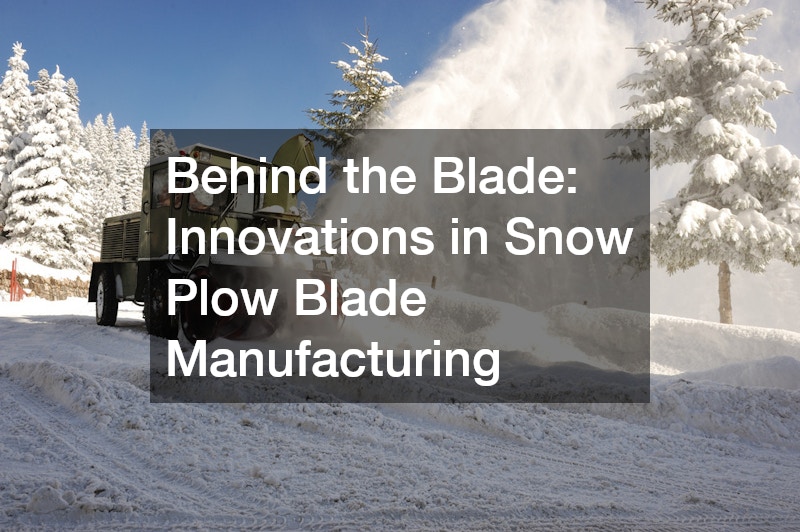The evolution of snow plow blades reflects an ongoing journey of innovation and adaptation to meet the demands of winter weather. These blades play a crucial role in keeping roads safe and navigable during harsh winter storms. In recent years, advancements in their manufacturing process have resulted in more efficient, durable, and environmentally friendly products.
Material Advancements
Recent innovations in material science have led to the use of high-strength steel alloys and innovative composites in snow plow blade manufacturing. These materials provide enhanced durability and resistance to wear and tear, essential for the demanding conditions encountered during snow removal.
Furthermore, the shift towards lighter materials helps improve the efficiency and fuel economy of snow removal vehicles.
Incorporating cutting-edge materials also allows manufacturers to design blades that are both stronger and more flexible. This flexibility aids in better contouring to road surfaces, minimizing the risk of damage to infrastructure. Ultimately, these material advancements translate to longer-lasting products, reducing the frequency of replacement and maintenance needs.
Another advantage of using advanced materials is the potential for cost savings. By extending the lifespan of snow plow blades, municipalities and other organizations can lower their overall operational expenses. As a result, contract manufacturing firms are increasingly adopting these modern materials to stay competitive and meet client demands for high-performance products.
Technological Integration
The integration of technology in snow plow blade manufacturing is revolutionizing the industry. Robotics and automation have streamlined production processes, increasing precision and reducing human error. This automated approach allows for rapid scaling of production, meeting the high demands of winter seasons efficiently.
Computer-aided design (CAD) has also become a cornerstone of blade development, enabling more accurate and innovative designs. With CAD, engineers can simulate stress tests and predict wear patterns, leading to better product durability. This technological leap ensures that each blade produced meets stringent quality standards, enhancing the reliability of the final product.
Environmental Considerations
The push towards sustainability is evident in the snow plow blade manufacturing industry as eco-friendly practices become more prevalent. Manufacturers are increasingly prioritizing recyclability and reducing the carbon footprint in their production processes. This includes the use of recycled materials and adopting energy-efficient technologies in their facilities.
In addition to material recycling, innovative coatings that reduce friction and wear have been developed, prolonging the lifecycle of snow plow blades. These coatings not only enhance blade performance but also contribute to lesser environmental impact over time. For consumers, selecting blades manufactured with these considerations aligns with broader environmental goals and regulations.
Cost Efficiency
Contract manufacturing plays a pivotal role in reducing production costs for snow plow blades. By outsourcing production to specialized manufacturers, companies can take advantage of economies of scale, leading to significant cost savings. These savings enable reinvestment in research and development for further innovations.
Additionally, contract manufacturers often operate in regions with lower labor costs, further driving down production expenses. This allows the original equipment manufacturers to offer competitive pricing on their products without compromising on quality. The flexibility in resource allocation afforded by contract manufacturing allows businesses to focus their efforts on core competencies, such as design and innovation.
Supply Chain Flexibility
The utilization of contract manufacturing offers significant benefits in terms of supply chain flexibility for snow plow blade production. Contract manufacturers can quickly adapt to changing demands and expedite production in response to weather patterns. This ensures that inventory levels remain sufficient to meet consumer needs even during peak winter seasons.
Such flexibility also allows companies to enter new markets or increase their geographical reach without substantial capital investments in new facilities. By partnering with various contract manufacturers, snow plow blade producers can leverage global networks to ensure prompt delivery to diverse locations. This geographical advantage further enhances the competitive stance of companies utilizing contract manufacturing.
Regulatory Compliance
The regulatory landscape presents another significant challenge to the snow plow blade manufacturing industry. Regulations often vary across regions, requiring manufacturers to navigate complex compliance standards. Adhering to these requirements demands a comprehensive understanding of both local and international laws, which can be resource-intensive.
Manufacturers must invest in staff training and infrastructure updates to ensure adherence to evolving regulations. This commitment often involves auditing processes and implementing quality management systems that comply with stringent standards. Contract manufacturers well-versed in diverse regulatory frameworks can offer invaluable support in meeting these compliance challenges.
Staying informed of regulatory changes is imperative for avoiding costly penalties and reputational damage. Manufacturers that proactively engage with regulatory bodies and participate in industry associations gain insights into upcoming legislative shifts. This proactive approach allows for timely adjustments and fosters a reputation of integrity and compliance within the industry.
Labor Shortages
The snow plow blade manufacturing industry is also contending with a growing labor shortage, posing challenges to production capacity and innovation. A declining skilled labor pool contributes to increased competition among manufacturers for qualified personnel. This scarcity exacerbates operational costs, as companies must offer competitive wages and incentives to attract talent.
In conclusion, innovations in snow plow blade manufacturing are driven by advancements in materials, technology, and environmental considerations. Contract manufacturing plays a pivotal role in enhancing cost efficiency, supply chain flexibility, and quality control. As the industry navigates challenges such as supply chain disruptions, regulatory compliance, and labor shortages, staying at the forefront of innovation ensures a resilient and sustainable future for snow plow blade manufacturing.
.


